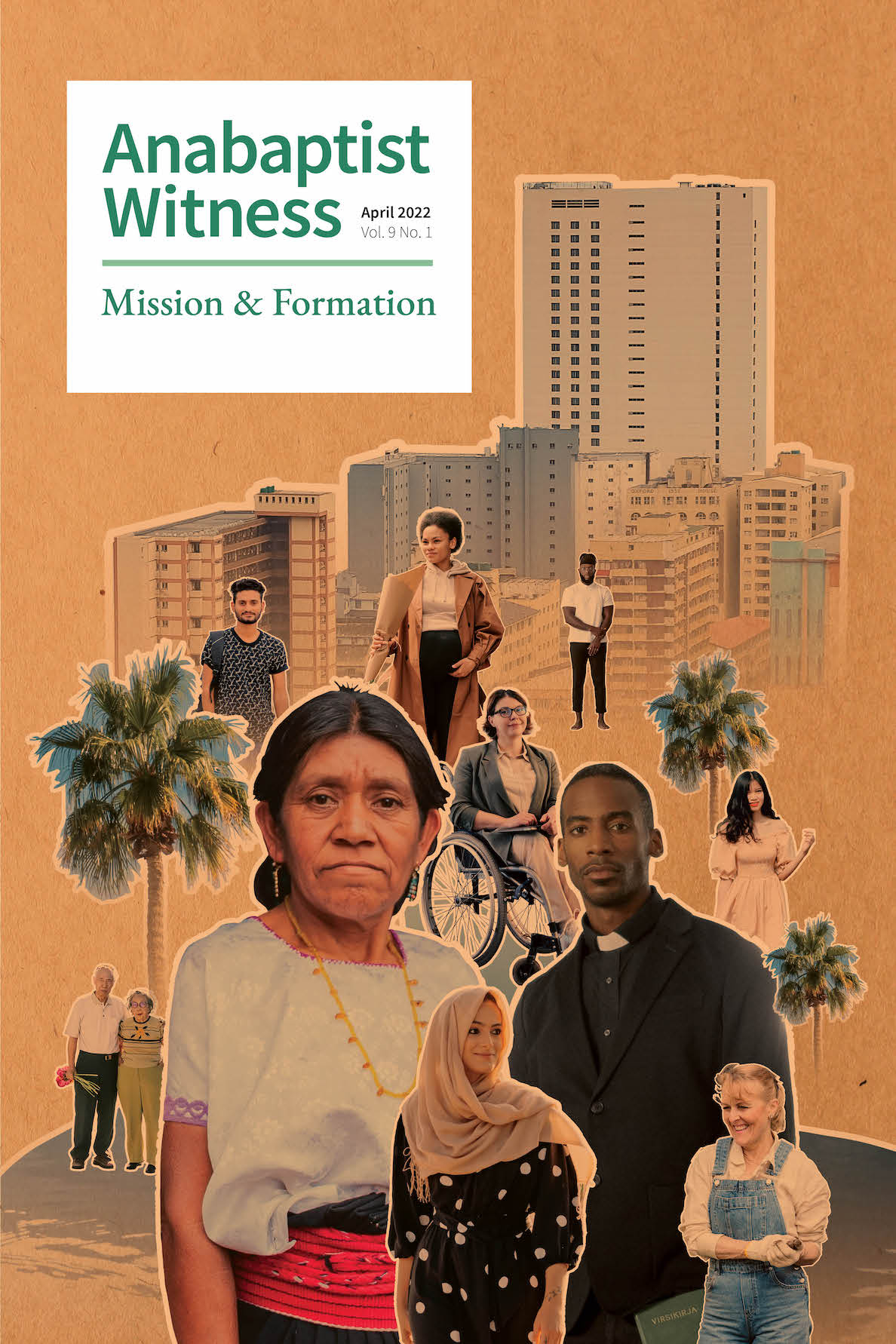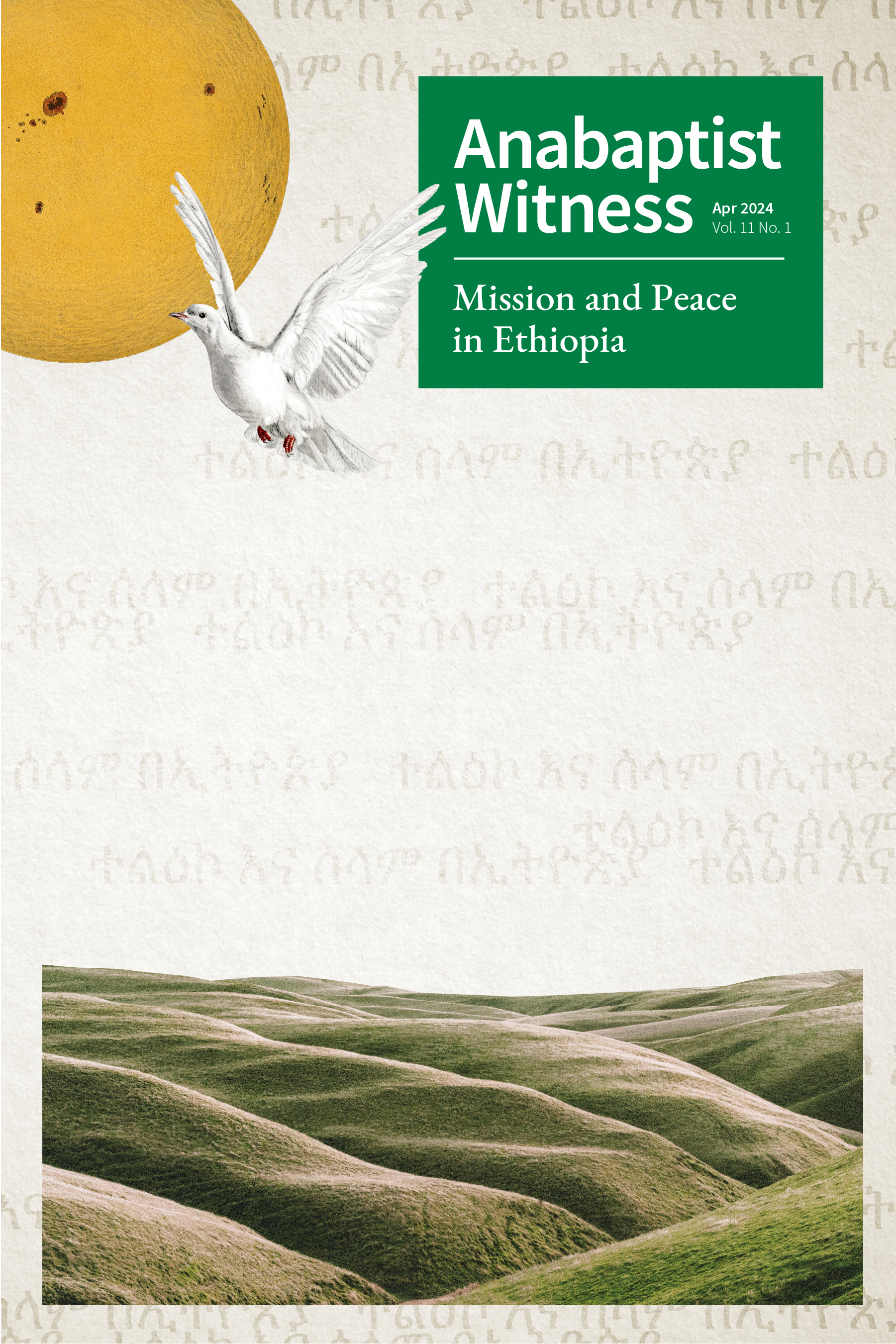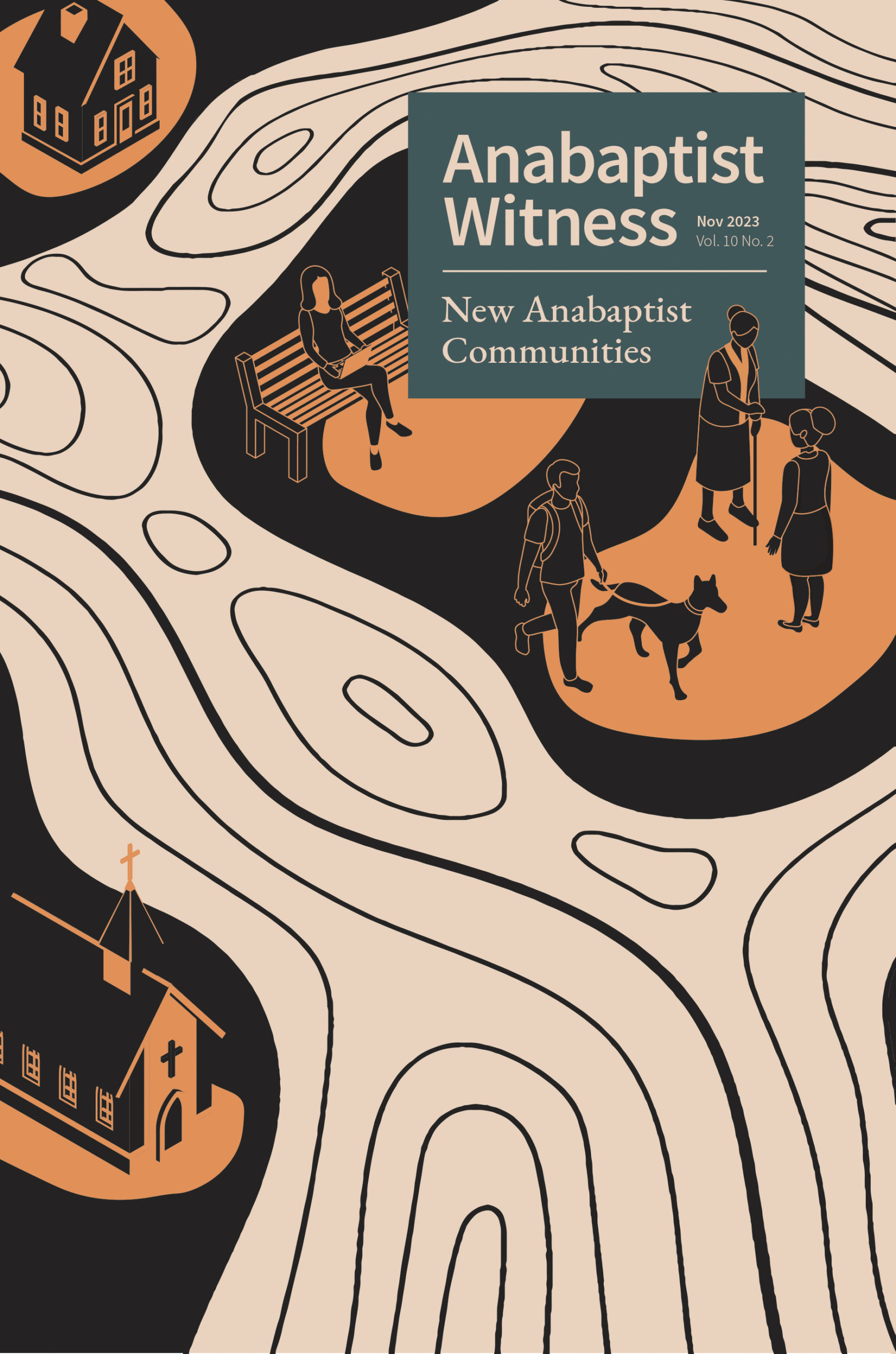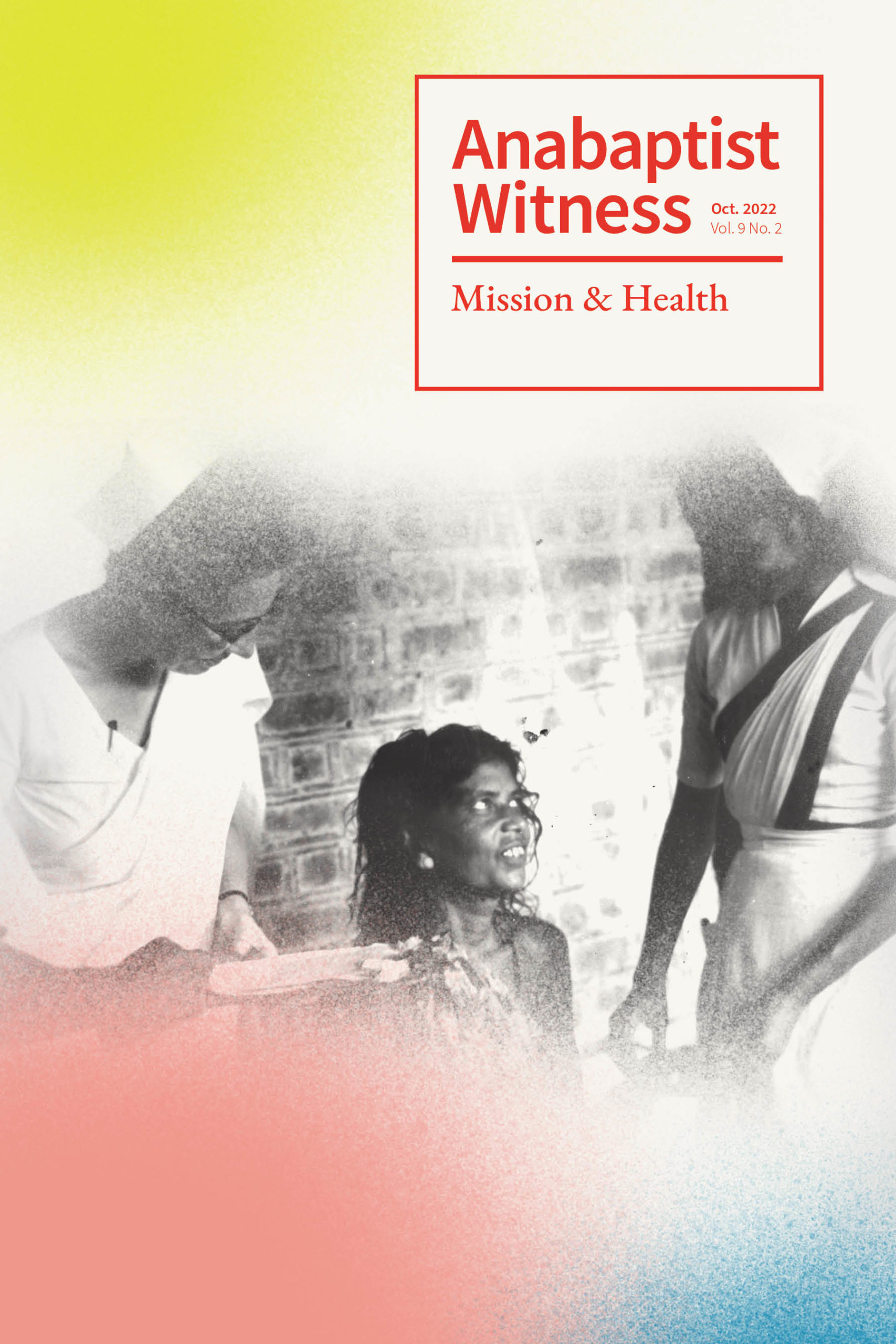Mission & Formation
About This Issue Download this issue
Mission & Formation
How are Anabaptists formed for witness? Our vision for this issue of Anabaptist Witness is to call attention to such formation, broadly construed as a dynamic process where external and internal forces shape Anabaptists as persons and communities that, in turn, impact witness. As such, we cannot conceptualize Anabaptist witness without seeking an understanding of the formation that gives rise to this witness. This formation is situated, meaning that social, cultural, ethnic, racial, gender, socioeconomic, and other contextual aspects profoundly shape our lives and witness.
At the same time, how does engaging in witness form Anabaptists? The impact of witness is not one-directional; the act of narrating how faith has influenced one’s life creates and hones frameworks of meaning for the witnessing person. Moreover, the recipient of witness—hopefully as a co-participant in the witnessing event—necessarily has an impact on the person who bears witness. Every context of witness, every intersection of experience and worldviews, has a formative effect on the witnesser because witnessing is done through deep dialogue—a space of mutual interaction and transformation. As guest editors, we build this issue of Anabaptist Witness on the cyclical premise that Anabaptists are formed for witness and that witnessing forms Anabaptists.
We believe that authentic Christian witness emerges when we faithfully practice the teachings of Jesus. As such, theological formation, ethics and discipleship, and witness and mission are deeply interconnected in many Anabaptist streams. Theological education aims to equip and form people to live out this calling of discipleship in society. Hence, theological education and formation undergird Christian witness.
Recent scholarship from theologians such as Willie James Jennings and Kwok Pui-lan has drawn our attention to the processes and products of formation. Analyses from Jennings, Kwok, and their colleagues in After Whiteness: An Education in Belonging, Teaching Global Theologies: Power and Praxis, and Theology without Borders: An Introduction to Global Conversations resound with a similar claim—theological education and formation in North America has been done predominantly through Western, Eurocentric, and individualistic lenses. Recipients of theological education in the church and academy alike are being formed into an image of the white, self-sufficient male. These voices sound an urgent challenge to diversify theological education and recognize the interconnectedness of formation, discipleship, and witness.
As Anabaptists whose vocation is located at the intersection of the church and the academy, we find formation into the hegemonic pattern of whiteness deeply problematic. For example, Mennonite churches in general privilege the “foundational” ethnicities—meaning Mennonites with Swiss, Dutch, Russian, and German backgrounds. As a result, their histories, faith stories, lived experiences, and theological perspectives are heavily centered. Those deemed “non-ethnic Mennonites” by the dominant cultural groups are often left minimal space to contribute to and influence the life and faith of the Mennonite churches in North America.
To counter this malformation and to enrich theological education and formation in our globalized and pluralist society, it is crucial to de-center the predominant lenses and to diversify and incorporate non-Western and traditionally marginalized voices, both in the academy and the church. These voices are calling for an evaluation of formation, and we hear them challenging Anabaptist witness in churches and schools in North America and beyond.
These voices also lead us as guest editors of this issue to ask self-critical questions: Whose theological insights do we typically utilize when we prepare a lesson, sermon, or academic paper? In response to this challenge, we have done curriculum audits and evaluated the sources for our sermons and scholarship in order to increase our reliance on sources that do not conform to whiteness. When we talk about Anabaptist/Mennonite identity and history, whose stories do we favor and whose experiences do we not count as Anabaptist? In seeking contributions to this issue, we have sought perspectives beyond dominant North American Mennonites of European descent, and we affirm as deeply Anabaptist those reflections from contributors whose identities are not white, male, non-disabled and located in the United States or Canada. Specifically, are white Anabaptists aware of how they are complicit—knowingly and unknowingly—with white supremacy, settler colonialism, and patriarchy when they engage in witness?
In light of this, we have included submissions in this issue that critique current patterns of Anabaptist/Mennonite education and formation and also offer constructive proposals rooted in authors’ particular contexts and traditions. Some submissions reflect self-critically on the author’s experience of formation and its impact on witness, while others explore the interconnectedness of formation, discipleship, and witness.
This issue seeks to promote a diversity of voices and to demonstrate the value of personal narrative, reflection that arises from congregational life, and academic scholarship. As such, a poem, personal reflections, and academic articles are interspersed to affirm these important theological contributions and facilitate creative imagination and learning that can arise from reading a rich diversity of perspectives and formats. Illustrative images also accompany some of the written pieces.
Sarah Werner’s poem, “The Kin-dom of Heaven,” foregrounds this issue. As someone with a visible disability, the author reflects where she has experienced belonging and acceptance and invites the readers to briefly dwell in an image of a summer camp. She depicts it as a place and space where humans are near to nature, people from diverse backgrounds can come together and enjoy each other’s presence, and everyone feels belonging in the midst of their differences. Werner names this place and space as the kin-dom of heaven, because whiteness, ableism, or any other dominant-isms in society are de-centered and everyone is accepted just as they are. The poem, in a gentle way, encourages the readers what to unlearn and what to relearn as people of the kin-dom of heaven.
In “Icons of God in the World,” Emily Ralph Servant examines traditional images of God as impassive and powerful and explains how these images have negatively influenced Christians’ formation and witness. Moving beyond hegemonic images of God articulated and accepted as normative in white, male, Western perspectives, the author, based on the stories of Jesus, proposes a God who is relational and vulnerable. Through this shift of images, Servant argues that witnessing becomes dialogical and mutually transformative rather than unidirectional and seeking to convert the other. Christian formation thus occurs through encounters. In these encounters, Christians are aware that their understanding of God is limited, and they are open to learning more about God from others. The telos of this formation and witnessing, according to the author, is the unity in God and with God, where everyone experiences full belonging with their full selves, where differences are not erased but celebrated and viewed as gifts.
Robert Thiessen offers a personal reflection of his formation in mission at the intersection of indigenous Mexican culture and white missionary influence in “Formation for Witness: Anabaptist Lessons Learned Far from Home.” Among the Metlatonoc Mixtecs, Thiessen experienced a profound formation in a new understanding of Anabaptism that he had not received in his Mennonite Brethren home community in Ontario, Canada. He recounts the impact of white non-Anabaptist missionaries as well as indigenous believers who taught him, in the context of their mutual participation in witness, core values of Anabaptism that he now holds dear.
Sarah Ann Bixler offers the image of the Möbius loop in “Mission as Distraction? A Critical Twist on Formation and Mission in Anabaptist Communities on the Möbius Loop” to illustrate the relationship between formation and witness. She conceives of the relationship as a perpetual inner-outer exchange, where the two co-create each other. Drawing from missional theologians within and beyond Anabaptism, Bixler points out a tendency she observes in Anabaptist thought and practice to either collapse formation and witness or to emphasize external witness as a distraction from unhealthy formation within the Anabaptist community. She explores a recent conflict in the LMC Anabaptist community in light of this latter concern, calling for renewed attention to both formation and witness in the life of the church in a way that honors each practice as distinct yet congruent.
In “Anabaptist Hermeneutical Formation and Witness in Meserete Kristos Church of Ethiopia,” Endaweke Tsegaw explores how the formation of the Meserete Kristos Church (MKC) was influenced by North American Anabaptist missions. Examining early and recent Anabaptist biblical interpretation and theological emphases, Tsegaw identifies echoes of these commitments in the formation of MKC that emerged in the mid-twentieth century. He describes six formational Anabaptist practices in MKC: congregational hermeneutics, Christocentrism, nonviolent resistance, church and state relations, women as leaders in the church, and historical critical biblical interpretation. In conclusion, Tsegaw calls all Anabaptist Mennonite communities to likewise reflect on their formation and Anabaptist hermeneutical commitments that prepare them for witness.
Kimberly Penner analyzes malformative narratives about sexuality and their impact on Anabaptist witness and discipleship in “Formed as (Sexual) Peacemakers? Interrogating the Role of Sexuality in Relation to Institutional Culture for Formation for Witness and Discipleship at Postsecondary Theological Schools.” By exploring religious narratives about sexuality and institutional culture in Anabaptist-Mennonite postsecondary institutions, she calls attention to the problems of discrimination and abuse currently inherent in the formation of students in peace and justice. Drawing on the insights of Willie James Jennings, Penner calls these institutions to resist malformation and be intentional about embodying cultures of peace and justice in relationship to sexual ethics, in order to form students with integrity for witness and discipleship.
Jennifer Davis Sensenig’s article, “Formed for Witness by the Biblical Story,” examines how some Mennonite pastors are utilizing the Narrative Lectionary, a ministry tool that schedules scripture readings based on the church year to assist congregational faith formation. The twenty-two pastors she interviewed reported being shaped by the biblical stories and, at the same time, deepening their understanding of the stories through connecting scripture texts with their own social contexts. The article indicates a few limitations of the material but strongly recommends it as a great tool to help congregations engage more with scripture and provide natural opportunities for them to be captivated by the sacred stories of the Bible. This approach to faith formation invites each reader and congregation to bring questions and struggles that emerge from their own unique contexts and experiences. And through this engagement with the sacred stories, the hope is that the people will discover good news to share with their communities, a message that deeply resonates with and transforms the lives of the people of those communities.
By highlighting the voices and experiences of these authors, we, as co-editors of this issue, hope to unsettle the predominant Anabaptist-Mennonite approaches of formation and witnessing so that more richly diverse approaches emerge within our academic institutions and churches. The book and film reviews that conclude the issue further this goal through reflections on the global church, race, and ecology. May these writings deepen and broaden our theological imagination and formation so that we can faithfully walk and witness as disciples of Jesus in an ever more pluralistic and diversified society and world.
Guest editors:
—Sarah Ann Bixler
Associate Dean of the Seminary and Assistant Professor of Formation and Practical Theology, Eastern Mennonite University, Harrisonburg, VA, USA
—Hyung Jin “Pablo” Kim Sun
Senior Leader for Anti-Racism and Intercultural Conciliation, Christian Reformed Church within Canada




